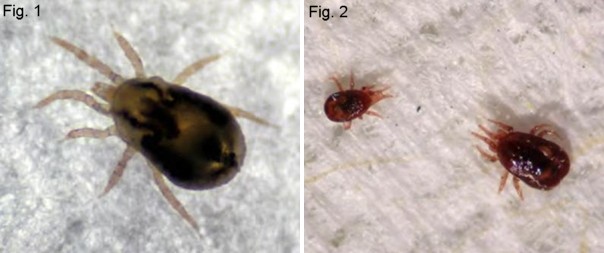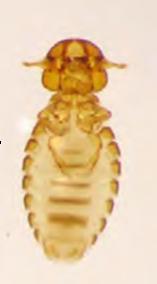External Mite and Insect Parasites of Backyard Chickens
ENTFACT-516: External Mite and Insect Parasites of Backyard Chickens | Download PDF
by Lee Townsend, Extension Entomologist
University of Kentucky College of Agriculture
The growing interest in raising chickens hasproduced a surge in backyard coops. There are many benefits to this enterprise but mite or lice problems that can adversely affect egg production and general flock health can develop quickly. Prevention and control options are available but often the problem is severe before it is recognized.
Mites
The two mite species that are most likely to cause significant problems in backyard chicken flocks are the northern fowl mite (NFM) and the chicken mite (CM), also called red mite or roost mite. These tiny arthropods are very similar in some ways but very different in others.
Both species are very small – Adults are about 1/25-inch long, immature stages are even smaller; hundreds to thousands may be present before a problem is detected. Larger, well-established infestations present a challenging control problem.

Fig. 1: Northern fowl mite
Fig. 2: Nymph (left) and adult chicken mite
Both are blood feeders – Feeding by large numbers of these mites irritates and stresses birds making them more susceptible to other problems- anemia, diseases, and reduced egg production. Both mites will bite humans if they get on the skin but do not infest them.
Development of either mite from egg to adult takes about 7 to 10 days under favorable conditions so numbers can increase rapidly.
Spread – The NFM is commonly spread by direct contact between infested and uninfested birds but infestations can begin with a few mites left behind by wild birds visiting feeders or sitting on enclosures or shelters. The CM can be spread by direct contact or may be introduced on transport cages or used shelters, etc.

Fig. 3: Chicken biting louse has six legs, a flat body, and wide head.
Lice
Poultry lice are insects that feed as external parasites on chickens and other birds. They spend their entire life feeding and climbing around on the skin and feathers.
Chewing mouthparts are used to feed on skin scales, scabs, and feathers, they are not blood feeders. These biting lice usually are spread by direct contact. However, they can survive off of the host for about a week so they can be carried in transport cages or left in shelters. Their life cycle takes from one to two weeks.

The differences between NFM and CM behavior affect how, when, and where to check for them and where control efforts should be directed. NFM are always on the birds and usually are most numerous on those up to about 30 weeks old. Mite numbers tend to decline on older birds. These dark red to black mites are most numerous around the vent (anal) area; feathers there become black with dried blood and mite excrement.
Control of CM is directed at cracks and crevices in the shelter and roosting area because this is where these mites spend much of their time. Their eggs are not susceptible to most insecticides so a follow-up application is very important to kill mites that were in the egg stage at the time of the first treatment. CM can survive for months without feeding so they cannot be controlled by removing the birds for a few days in hopes of starving them.
Management Tips
- Examine birds carefully before purchase for signs of mites or lice. Do not buy obviously infested birds.
- Assume all birds that you purchase are infested.
- Treat them with a labeled insecticide according to directions. Check label for age restrictions of birds and re-treatment interval.
- Keep newly-purchased birds away from others in the flock until the treatment course is completed.
- Carefully dispose or thoroughly clean any crate, cage, or boxes in which purchased birds are transported to reduce the chances of CM infestation.
- Exclude wild birds from contact with chickens, coop, or feed. They can be a source of parasite problems.
Examine birds regularly
Check the vent area of a portion of the flock every two weeks for NFM. Use a flashlight or check in bright daylight; the light will cause the mites to move, making them easier to see. Mites may be seen on eggs when they are gathered.
You are most likely to detect CM infestations by checking birds at night. However, you may find their feeding lesions on the breast and lower legs when examining birds for NFM. If you suspect CM, check cracks and crevices or manure accumulations on the floor of the structure for clusters of resting mites.
Control tips
Insecticides used for control of poultry pests may not be available in stores that sell products for the landscapes and gardens. Check with local farm supply stores for appropriate insecticides.
Check the label carefully to see if the product is labeled for application to birds, roosting areas, or both.
Control of NFM and lice is focused on the birds. Focus treat on the vent area for northern fowl mites. Treat the birds thoroughly. Check for live mites or lice in 7 to 10 days and make follow-up applications as needed. Treat all birds at the same time and apply the insecticide so that it reaches the skin.
When treating for chicken mites spray or dust cracks and crevices thoroughly. Make a follow-up application in 5 to 6 days; infestations are rarely controlled with a single treatment.
Follow instructions on the insecticide label regarding how often applications can be made.
Example Insecticides
Spray concentrates or dusts containing permethrin (e.g. GardStar or Prozap Garden & Poultry Dust). This insecticide provides quick knockdown of pests and has a relatively long residual life.
Carbaryl 5% Dust – apply to birds for NFM and lice control. Use as a premise treatment for CM control – apply to roost and litter. This product provides good knockdown of pests and a moderate residual life.
PyGanic Dust or PyGanic Pro Spray (pyrethrins) apply to cracks and crevices for CM control or directly to birds for NFM and louse control. This insecticide provides quick knockdown of pests but has a short residual life.
Issued: 7/12
CAUTION! Pesticide recommendations in this publication are registered for use in Kentucky, USA ONLY! The use of some products may not be legal in your state or country. Please check with your local county agent or regulatory official before using any pesticide mentioned in this publication.
Of course, ALWAYS READ AND FOLLOW LABEL DIRECTIONS FOR SAFE USE OF ANY PESTICIDE!
Images: University of Kentucky Entomology
